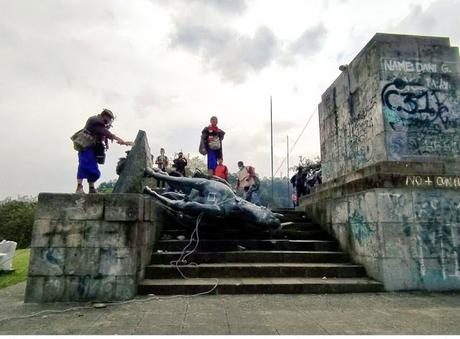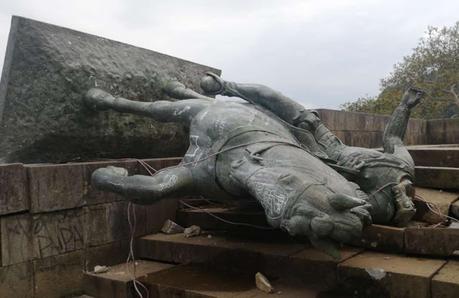Another statue falls down – another one bites the dust. A casual browsing of today’s occurrence introduced me to Popayan city, and hitherto unheard words – ‘encomienda’; ‘Conquistadors’.
 Popayánis the capital of the Colombian department of
Cauca. It is located in southwestern Colombia between the Western Mountain
Range and Central Mountain Range. The town is well known for its colonial
architecture and its contributions to Colombian cultural and political life. It
is also known as the "white city" due to the color of most of the
colonial buildings in the city center.The University of Cauca (est. 1827), one of
Colombia's oldest and most distinguished institutions of higher education, is
located here. Much of the city's original splendor was
destroyed on 31 March 1983, when an earthquake toppled many buildings. Though
many were rebuilt and repaired, the heart of the city still has ruins and empty
lots.
Popayánis the capital of the Colombian department of
Cauca. It is located in southwestern Colombia between the Western Mountain
Range and Central Mountain Range. The town is well known for its colonial
architecture and its contributions to Colombian cultural and political life. It
is also known as the "white city" due to the color of most of the
colonial buildings in the city center.The University of Cauca (est. 1827), one of
Colombia's oldest and most distinguished institutions of higher education, is
located here. Much of the city's original splendor was
destroyed on 31 March 1983, when an earthquake toppled many buildings. Though
many were rebuilt and repaired, the heart of the city still has ruins and empty
lots.
The encomienda was a Spanish labor system that rewarded conquerors with the labor of particular groups of conquered non-Christian people. The laborers, in theory, were provided with benefits by the conquerors for whom they labored, the Catholic religion being a principal benefit. The encomienda was first established in Spain following the Christian conquest of Moorish territories (known to Christians as the Reconquista), and it was applied on a much larger scale during the Spanish colonization of the Americas and the Spanish Philippines. Conquered peoples were considered vassals of the Spanish monarch. The Crown awarded an encomienda as a grant to a particular individual. In the conquest era of the sixteenth century, the grants were considered to be a monopoly on the labor of particular groups of indigenous peoples, held in perpetuity by the grant holder, called the encomendero, and his or her descendants.
Conquistadors (from Spanish and Portuguese for 'conqueror') were the knights, soldiers and explorers of the Spanish and the Portuguese Empire. During the Age of Discovery, conquistadors sailed beyond Europe to the Americas, Oceania, Africa, and Asia, conquering territory and opening trade routes. They colonized much of the world for Spain and Portugal in the 16th, 17th, and 18th centuries. After arrival in the West Indies in 1492, the Spanish, primarily nobles from the west and south of Spain, began building an American empire in the Caribbean using islands such as Hispaniola, Cuba, and Puerto Rico as bases. In Colombia, Bolivia, and Argentina conquistadors from Peru linked up with other conquistadors arriving more directly from the Caribbean and Río de la Plata-Paraguay respectively. All these conquests founded the basis for modern Hispanic America and the Hispanophone.
Sebastián de Belalcázar (1480 – 1551) was a Spanish conquistador. De Belalcázar, is known as the founder of important early colonial cities in the northwestern part of South America; Quito in 1534 and Cali, Pasto and Popayán in 1537. De Belalcázar led expeditions in present-day Ecuador and Colombia and died of natural causes after being sentenced to death in Cartagena, at the Caribbean coast in 1551.
He was born Sebastián Moyano in the province of Córdoba, Spain, took the name Belalcázar as that was the name of the castle-town near to his birthplace in Córdoba.According to various sources, he may have left for the New World with Christopher Columbus as early as 1498, but Juan de Castellanos wrote that he killed a mule in 1507, and fled Spain for the West Indies due to fear of punishment, and as a chance to escape the poverty in which he lived. He was an encomendero in Panama in 1522. He entered Nicaragua with Francisco Hernández de Córdoba in 1524 during the conquest of Nicaragua, and became the first mayor of the city of León in Nicaragua. He remained there until 1527, when he left for Honduras as a result of internal disputes among the Spanish governors.

His battles, though, were not entirely honourable. At a village called Quinche near Puritaco, he found that all the men were away fighting with the national army. To make an example of these people (and to vent his frustration at finding so little treasure), he ordered all the women and children to be slaughtered. 'A feeble excuse to justify cruelty unworthy of a Castilian', was the verdict of Herrera, the official Chronicler of the Conquest, to Belalcázar's excuse that this was done to terrify other natives into returning to their homes. In 1546, he ordered the execution of Jorge Robledo, who governed a neighboring province in yet another land-related vendetta. He was put to trial in absentia in 1550, convicted and condemned to death for the death of Robledo, and other offenses pertaining to his constant involvement in the various wars between other conquistadors. A victim of his own ambition, he died in 1551 before he could begin the voyage back to Spain to appeal the decision, in Cartagena, Colombia.
Now comes the news that indigenous protesters in Colombia have toppled a statue of Spanish conquistador Sebastián de Belalcázar in the south-western city of Popayán. Police looked on as members of the Misak community used ropes to tear down the equestrian figure of de Belalcázar, who founded the city in 1537. Indigenous leaders said he represented five centuries of genocide and slavery. Popayán's mayor said it was an act of violence against a symbol of a multicultural city. The Misak community blames the conquistador for the killings of their ancestors and land grabbing. The toppling of statues associated with slavery and colonialism has been a prominent feature of the Black Lives Matter protests in the US and Europe.
History getting re-written !
With regards – S. Sampathkumar17.09.2020.

